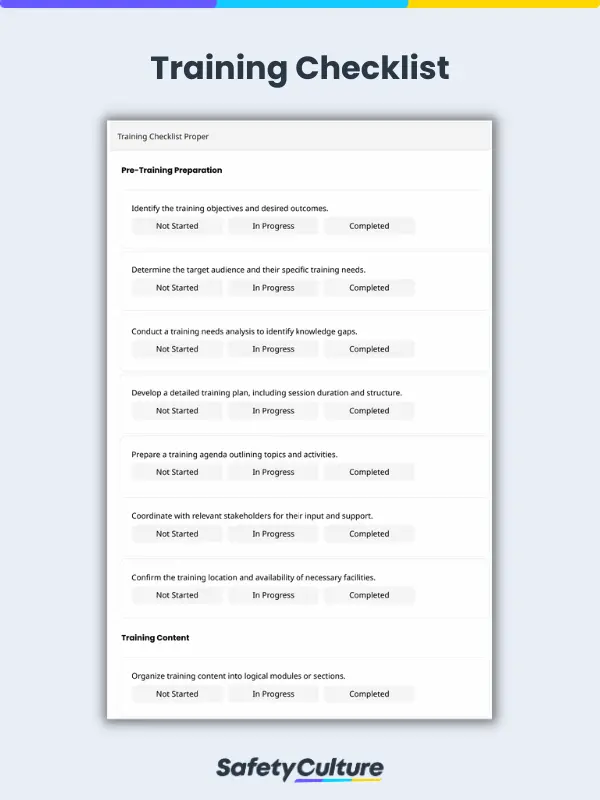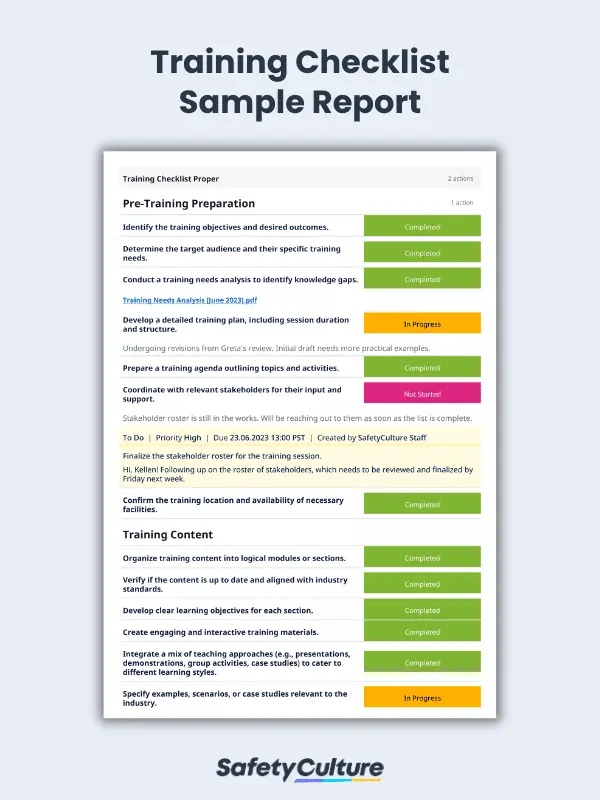What is a Training Checklist?
A training checklist is a guidance document that maps out the steps and components required in preparing, carrying out, and evaluating a training program. Training coordinators and facilitators can use this checklist before each training session to develop effective plans covering all important aspects. This way, they can consistently deliver comprehensive and high-quality training sessions for new hires and existing employees.
Purpose and Importance
A training checklist is a valuable resource for conducting training activities in organizations. It aims to promote a consistent and streamlined approach using a framework that encompasses the entire training process. By laying the groundwork for essential tasks and elements, trainers can efficiently and effectively carry out their training programs as planned. But how does it do it?
First, a training checklist establishes the learning objectives and goals to achieve in the duration of the program. With a clear vision of the training’s purpose, training teams can design relevant content for their target audience and choose appropriate instructional methods that align with the needs of the learners and the organization. For example, they can develop beginner-friendly training courses for orienting new hires on their role.
Furthermore, this checklist helps trainers address all training segments, as it enumerates the tasks, activities, facilities, resources, and evaluation methods to use during training sessions. By going through the items on the checklist, they can ensure that no vital aspects are overlooked.
Ultimately, a training checklist improves the quality and effectiveness of training programs by establishing a structured approach to planning and delivering training. This way, organizers can provide a solid learning experience and maximize the learning outcomes for the participants.
Types of Training Checklists
Training checklists are designed to assist facilitators, trainers, and organizers throughout the training process. Each type of checklist corresponds to a specific training stage: preparation, program development, session delivery, and assessment. This section takes a closer look at these types:
Training Preparation Checklist
This checklist covers the key tasks and considerations before a training program begins to set the stage for a successful learning experience. It involves the following activities:
- Defining training goals and objectives
- Assessing the needs of the target audience
- Choosing appropriate training methods and materials
- Securing necessary resources for the training session
- Setting the venue, schedule, and other logistical needs of the training
Training Program Checklist
This type of training checklist helps develop and organize the training content and structure. By using this checklist, trainers can align their content with the learning objectives and curate a productive learning experience for participants. Here are a few items to get you started with building this checklist:
- Drafting a detailed training outline
- Arranging training sessions or modules
- Designing lesson plans and instructional materials
- Integrating interactive activities and multimedia elements in the presentation
Training Session Checklist
This checklist is used during individual training sessions to ensure that it relays the intended knowledge and skills to the participants in a structured and engaging manner. When creating this checklist, be sure to include the following:
- Establishing a conducive training environment
- Checking technical requirements
- Welcoming participants
- Facilitating discussions and interactions
- Addressing questions and concerns
- Summarizing key points to wrap up the session
Training Evaluation Checklist
A training evaluation checklist measures the impact and effectiveness of the training program. Organizers can take advantage of the insights from this form to continuously enhance their training initiatives and better align with organizational goals and trainee needs.
- Setting the evaluation criteria and objectives
- Choose the appropriate evaluation method (e.g., surveys, assessments, interviews)
- Gathering and analyzing data and feedback
What to Include in this Checklist
Given the varying types of training checklists, what information should you include? Here are the essential sections to cover in your training checklist:
- Pre-Training Preparation – Map out the initial details of the training before planning out its content and logistics. Make sure to specify the training objectives, desired outcomes, target audience, needs analysis, agenda, and other relevant information.
- Training Content – Next, identify the topics, activities, and information to be discussed during the training. Also, indicate the training methods, examples, and visual aids that you’ll be using for the session.
- Training Materials and Resources – Determine the materials, resources, and learning aids needed for the training. These can include software, tools, handouts, and other reference materials.
- Training Logistics – Outline and finalize where, when, and how the training will take place. Make sure to cover the training schedule, location, travel routes, and technical equipment needed.
- Evaluation and Feedback – Set benchmarks to gauge the effectiveness and quality of the delivered training program. Incorporate a good mix of pre-training and post-training assessments, feedback sessions, and evaluation forms to fully encompass the thoughts and feedback from the participants.
Training Checklist Example
To illustrate how this document works, here’s an example of a completed training checklist:
Training Checklist FAQs
Creating and using a training checklist involves collaboration among multiple stakeholders in the organization: training coordinators, subject matter experts, and trainers. Do note that these roles can change based on the organizational structure and the complexity of the training program.
Training checklists should be reviewed periodically (e.g., quarterly, semi-annually, or annually). Setting this interval ensures that training teams account for any significant change in the training content, materials, or procedures. This frequency can be tailored to the specific circumstances or needs of the organization.
Organizations can consider these 3 strategies to maximize the use of the training checklist in carrying out the training program:
- Provide clear instructions and resources for each checklist item.
- Utilize a learning management system for tracking progress and collecting feedback.
- Regularly assess the effectiveness of the checklist to find improvement opportunities.




